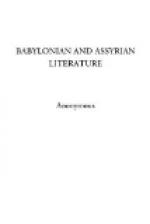Now Ishtar lifts her eyes within a room
Prepared for her, and sees her maidens come,
Before a weird procession wrapped in palls,
That soundless glide within and fills the halls.
Before her now they place a sable bier
Beside the fount; and Ishtar, drawing near,
Raised the white pall from Tammuz’s perfect
form.
The clay unconscious, had that mystic charm
Of Beauty sleeping sweetly on his face,—
Of agony or sorrow left no trace:
But, oh! that awful wound of death was there
With its deep mark;—the wound, and not
the scar.
When Ishtar’s eyes beheld it, all her grief
Broke forth afresh, refusing all relief;
She smote her breast in woe, and moaning cried,
Nor the bright waters to his wound applied:
“O Tammuz! Tammuz! turn thine eyes on me!
Thy queen thou didst adorn, before thee see!
Behold the emeralds and diamond crown
Thou gavest me when I became thine own!
Alas! he answers not: and must I mourn
Forever o’er my love within this bourne?
But, oh! the waters from this glowing stream!
Perhaps those eyes on me with love will beam,
And I shall hear again his song of love.
Oh, quickly let these waters to me prove
Their claim to banish death with magic power!”
Then with her maids, she o’er his form doth
pour
The sparkling drops of life—
“He moves! he lives!
What happiness is this my heart receives?
O come, my Tammuz! to my loving arms!”
And on breast his breathing form she warms;
With wondering eyes he stares upon his queen,
And nestling closed his eyes in bliss again.
[Footnote 1: “Asherim,” literally “stone stakes” or “cones,” the symbols of the goddess Asherah or Ishtar (Sayce), but Calmet says that the god Ashima is a deity of very uncertain origin, and that the name “Ashima” may be very well compared with the Persian “asuman” ("heaven"); in “Zend,” “acmano,” so Gesenius in his Man. Lex., 1832. This also, according to the magi, is the name of the angel of death, who separates the souls of men from their bodies, Cal. Dic., p. 106. Cones are to be seen in the British Museum which are probably of the character which represented Elah-Gabalah, the sun-god, adored in Rome during the reign of Heliogabalus. The symbol and worship came from Hamath in Syria.]
COLUMN V
TAMMUZ IS RESTORED TO LIFE BY THE WATERS OF LIFE—HIS SONG OF LOVE
The nectared cup the queen placed to his lips,
And o’er his heaving breast the nectar drips,
And now his arms are folded round his queen,
And her fond kisses he returns again;
And see! they bring to him his harp of gold,
And from its strings, sweet music as of old
His skilful hands wake through the sounding domes;
Oh, how his Song of Love wakes those dark rooms!
“My Queen of Love comes
to my arms!
Her faithful eyes
have sought for me,
My Love comes to me with her
charms;
Let all the world
now happy be!
My
queen has come again!




